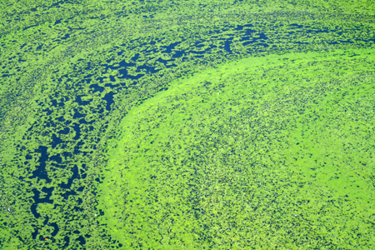Regulating Farm Pollution To Reduce Harmful Algal Blooms
By Emily Newton

As nutrient pollution increases the incidence and severity of harmful algal blooms, it is obvious and important to point mitigation practices toward a prime culprit — the agriculture industry.
Algae collectively comprise the water-dwelling organisms that give essential nutrients and oxygen to the surrounding aquatic environments through photosynthesis. However, harmful algal blooms (HABs) occur when algae growth becomes uncontrollable, threatening life above and below the water’s surface.
These blooms look different depending on whether they happen in freshwater or saltwater. Those in freshwater generally appear as a green, scum-like coating on the surface. However, ocean blooms are orange, brown, or pink colored, leading to their often-used “red tide” nickname.
HABs can occur naturally. For example, the aging of bodies of water causes the weakening of hydrologic flows and the buildup of sediment, both of which cause favorable conditions for the uncontrolled growth of algae. However, humans contribute to harmful algae blooms, too.
Agricultural runoff is one of the main causes, happening when phosphorus and nitrogen make their way into bodies of water from nearby farms. Both phosphorus and nitrogen can cause nutrient pollution that accelerates algal bloom growth.
Such nutrient pollution can also create so-called dead zones, where the water has little to no oxygen. The U.S. has more than 160 dead zones, including in the Gulf of Mexico, which is the largest.1 Nutrient pollution from the Mississippi River Basin causes that dead zone every summer.
Such consequences have led concerned people to assert that it’s time to take action against harmful algal blooms. It’s ongoing in the form of research, regulation, tracking, and reduction. Here’s a closer look at what’s happening.
Tracking Harmful Algal Blooms To Promote Knowledge
Scientists know that harmful algal blooms are more widespread than they once were. However, the first known instances of these events happened earlier than people realize.
A timeline from the U.S. National Office for Harmful Algal Blooms shows the earliest events of red tide occurring in Florida in 1844.2 However, a 1799 event, also listed on the timeline, concerned members of a Southeastern Alaska hunting party becoming ill after eating mussels.
Nearly 100 of the hunters died, and researchers believe the affected people ate mussels affected by paralytic shellfish poisoning. Some species of microscopic algae produce the associated toxin.
The U.S. Centers for Disease Control and Prevention lists six illnesses caused by algae-related poisons.3 People can get sick from eating contaminated seafood but also by swimming in water affected by algal blooms or breathing in the air surrounding them. A person’s symptoms depend on the length and type of exposure and how it occurred.
Since HABs threaten both human and environmental health, people need to stay abreast of how they occur and to what extent. That happens through various means.
Using Satellites To Watch For Algal Blooms
NASA has deployed several Earth-observing satellites to check bodies of water for possible algal blooms. People use the associated data to create chlorophyll maps. They show green areas on bodies of water that suggest the likely presence of current or impending excessive algae growth.
A 2017 case of using this monitoring method reportedly saved $370,000 for officials by allowing them to warn members of the affected community sooner than they otherwise could.4 They tested the water and then posted warnings for humans and their pets to stay away from the area in question.
Creating Forecasts To Monitor Trends
Forecasting is a critical part of planning in many industries. Coca-Cola uses it to determine the right times to deliver 500 million beverages to vending machines.5 Hospitals depend on it to ensure that facilities have the right resources to deal with flu outbreaks and other situations that typically cause strain. Forecasting also supports algal bloom management.
The National Centers for Coastal Ocean Science (NCCOS) creates short and long-term forecasts of HABs by region.6 The short-term ones happen once or twice a week, showing things such as the size of a bloom and its likely movement. Then, long-term forecasts aid officials in knowing the probable severity of a bloom season in a particular region. Algal blooms typically flourish in the summer when the water is warm.
However, scientists say other climate change-related effects could make them more severe.7 That reality could make forecasting even more important in the coming years, especially if climate change makes harmful algal blooms begin to show unexpected characteristics.
Implementing Regulations While Furthering Education
Most U.S. states have laws restricting the overall use and application of fertilizers.8 Those are a good start. However, it’s less common for states to also offer certifications and educational programs for people who use fertilizer, especially those doing so at the industrial level.
The people who plan and run such programs must put themselves in the positions of agricultural professionals and focus on the things that are most likely to get them to act. One angle to take is discussing the potential money saved by curbing the overuse of fertilizers.
Giving Farmers Practical Tips To Manage Agricultural Pollution
It’s also crucial to give farmers the knowledge and understanding needed to make positive changes to their practices. Some good starting points are to teach and encourage farmers to apply fertilizer with better accuracy. That means using it at the correct times and in the proper places, while distributing the correct amounts.
Agricultural professionals must take care to protect their assets from the elements. That often means ensuring structures such as barns have the appropriate waterproofing. Factors such as drainage systems, hydrostatic pressure, and buoyancy uplift are a few of the many things to consider when waterproofing a building.9
Setting aside time for building repairs or upgrades can also make farmers aware of damaged or missing fencing. Such infrastructure problems can contribute to harmful algal blooms by allowing livestock to access nearby natural water sources. When animals drink from them, they can introduce agricultural contaminants that eventually contribute to algal bloom activity.
A relatively new option is to create conservation buffers by planting trees, grasses, and shrubs along the edges of fields. This builds a barrier against agricultural runoff by absorbing nutrients or having a filtering effect before they reach the water. A 12-year study from The Nature Conservancy of such constructed wetlands showed they bring significant benefits. The research indicated that applying this technique to just 6% of the agricultural land could cause a 50% reduction in nitrogen.10
Another option is to make it easier for farmers to purchase equipment that reduces agricultural runoff. Nathan Nelson, a professor of soil fertility and nutrient management at Kansas State University, said equipment that injects phosphorus underground minimizes runoff. However, it’s usually expensive to buy and operate.11 If farmers could take advantage of rebate programs or similar incentives, they may find such investments more appealing and manageable.
Looking Toward The Future
Minimizing harmful algal blooms won’t be easy, but progress is more likely to happen with collective efforts. In one case, the Ohio Lake Erie Commission mentioned curbing nutrient pollution as its top priority in restoring and protecting Lake Erie.11 Some of the plans in the statewide effort include planting cover crops and building new wetlands.
However, other options exist, too. Researchers from the University of California-Davis explored how to use less fertilizer to grow rice in one recent example. They believe modifying the crops to produce a chemical that induces soil bacterial nitrogen fixation would enable reduced fertilizer dependence.12 Such efforts may not come into the mainstream for a while. Still, they highlight some of the fascinating possibilities.
It’s Time To Take Preventive Measures Against Harmful Algal Blooms
As this overview shows, individual farmers can take some thoughtful and practical steps to minimize the agricultural runoff that contributes to HABs. However, the most prolonged changes will likely come from policy makers who can use their power and influence to lay the groundwork for progress.
Now is an excellent time for legislators and others to prioritize HAB mitigation. Relatedly, concerned professionals and everyday citizens can pressure those parties through petitions and other types of collective action.
People familiar with the matter can recognize the ill effects caused by harmful algae blooms. Now, they must act to spur improvements in agriculture and other sectors.
References
- https://www.epa.gov/nutrientpollution/effects-environment
- https://hab.whoi.edu/about/historical-occurrence-of-habs/
- https://www.cdc.gov/habs/illness-symptoms-marine.html
- https://earthobservatory.nasa.gov/images/146983/early-detection-of-algaeyields-savings
- https://revolutionized.com/inventory-management-techniques-and-strategies/
- https://coastalscience.noaa.gov/research/stressor-impacts-mitigation/habforecasts/
- https://www.ceh.ac.uk/news-and-media/blogs/new-research-impacts-climatechange-harmful-algal-blooms-lakes
- https://nationalaglawcenter.org/state-compilations/nutrientmanagement/
- https://vitalstructuresllc.com/waterproofing/
- https://www.nature.org/en-us/about-us/where-we-work/united-states/illinois/stories-in-illinois/constructed-wetlands-reduce-agricultural-runoff-study/
- https://news.wosu.org/news/2020-02-18/algae-blooms-from-farm-runoffremain-top-concern-for-lake-erie
- https://www.ucdavis.edu/food/news/growing-rice-with-less-fertilizer
 About The Author
About The Author
Emily Newton is an industrial journalist. She regularly covers stories for the utilities and energy sectors. Emily is also editor in chief of Revolutionized (revolutionized.com).
